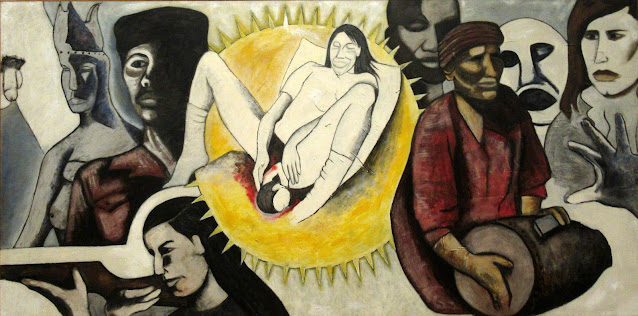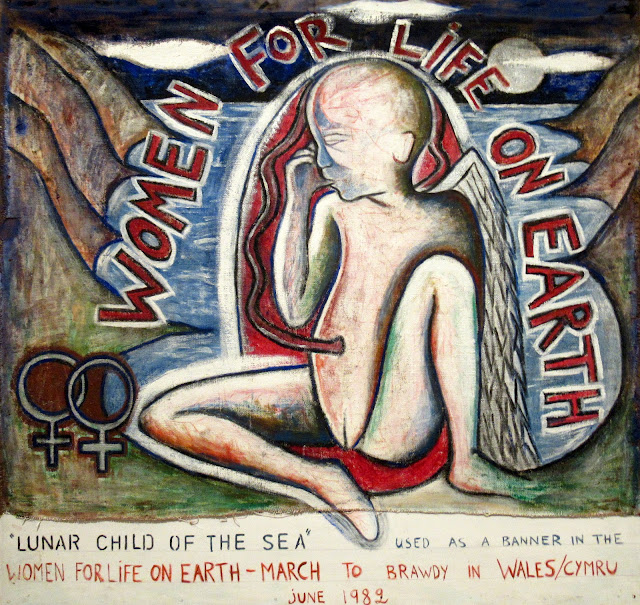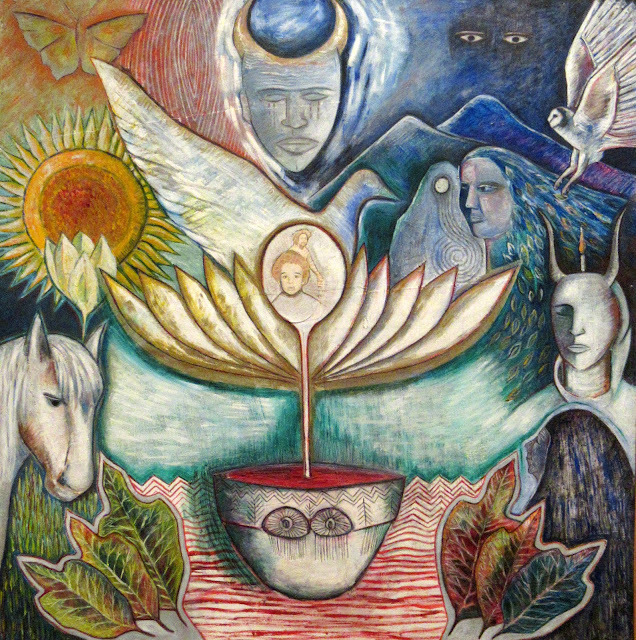Happy New Year to you all! Let's hope that 2024 is a better one.
Monica Sjoo - The Great Cosmic Mother
The Swedish artist, activist, writer and eco-feminist Monica Sjoo (1938-2005) anchored her creative work in an uncompromising fight for freedom from oppression in all its forms. Sjoo's works were created to be agents for change - both political and spiritual. Following the mantra 'no spirituality without politics', she came to be an influential figure in both the Women's Liberation Movement and the Goddess movement internationally. Tracing the artist's deep commitment to feminism and environmental justice, this retrospective exhibition considers Sjoo's artistic and activist practice - a practice that chimes with many social and political challenges and protest movements today.
Sjoo's political consciousness was formed early on by the Vietnam War protests, the anarchist movement, the independent art scene, and the women's movement. These experiences collectively shaped the foundation for her radical life as an artist and activist in Bristol, where she came to live for most of her life. Sjoo's work was controversial from the start. As a co-founder of Bristol Women's Liberation, Sjoo campaigned to end violence against women and protested for women's abortion rights, sexual autonomy and wages for housework. She visualised the demands of feminist activism through her vivid and bold paintings, merging forthright political slogans with images of women from across history and cultures. Sjoo also participated in several pioneering feminist group exhibitions at this time.
Gallery 1:
I loved the early paintings - such strong statements about women's oppression and the wish for liberation. I found the Great Mother ones difficult to relate to and I don't think they had the clear voice of the early ones.
In protests and campaigns for abortion rights and sexual freedom, Sjoo would often cite Goldman's words: 'Women need not always keep their mouths shut and their wombs open' on posters that were widely distributed.
Backstreet Abortion - Women Seeking Freedom from Oppression, 1968, (oil on masonite, textile)
Several of Sjoo's works depict her interpretations of ancient matriarchal societies, where religion centred on the figure of the Great Mother. In Sjoo's view, the Great Mother who is the motif of this painting, was the source of all life. When the painting was exhibited in the 1970s, it provoked strong reactions. At one point, Sjoo was reported to the police and accused of blasphemy and obscenity, but the charges were ultimately dropped.
Cosmos within her Womb, 1971, (oil on masonite)
Gallery 2:
During a heightened period of Cold War tensions, the British government agreed to house 'first-strike' nuclear weapons at a US Air Force base at Greenham Common in Berkshire in 1980, as well as mobilising a US naval presence at Brawdy in Wales, close to Sjoo's home. Sjoo responded by setting up a branch of the Campaign for Nuclear Disarmanent (CND) in Fishguard and making a banner for the emerging women's campaign at the request of Ann Pettitt, organising of the women's peace camp at RAF Greenham Common. The campaign group were eventually titled 'Women for Life on Earth' and expressed eco-feminist principles by significantly invoking 'life', rather than political resolution such as disarmament. Sjoo created another banner for the 'Women for Life on Earth' peace march from Cardiff to Brawdy in 1981, which she later collated onto a wooden board to create the painting Lunar Child of the Sea (1982).
Lunar Child of the Sea, 1982, (oil on canvas and masonite)
The Goddess in Her Manifestations at Greenham Common, 1984, (oil on masonite)
Sjoo travelled to Greenham in December 1982, joining the Embrace the Base action in which 30,000 women linked hands around the military airbase perimeter fence, singing, chanting and decorating the grid of chain links. Sjoo understood the women's peace camp as a contemporary channel for the Great Mother to reassert her influence against the acute threat to life on earth. Despite the increasing Cold War hostilities and fear of nuclear destruction, a women's community flourished at Greenham Common women's peace camp, interweaving anarchism, eco-feminism, ecological activism and spirituality in devotional acts of protest, dance and song.
Monica Sjoo depicted on a postcard from the Women for Life on Earth Peace March, 1981, (PVC free wallpaper)
Gallery 3:
Her eco-feminism dynamically merges with forthright environmental activism in this period. She worried about the heightened climate threat and was frequently engaged in different protest movements against man's abuse of the Earth. She sought to unite eco-feminist, political and spiritual messages in her painting, and anticipated the climate crisis protests of today.
Her political involvement in the women's and environmental movements were inextricably linked to her spiritual conviction. Her politics always included action. Her actions included her art, and she believed that her art was her activism.
Meeting the Ancestors at Avebury, 1993, (oilo on masonite, textile)
Sjoo was drawn to the womb-like underground burial chamber of West Kennet Long Barrow. The darkened entrance to the tomb is depicted in this painting. Sjoo writes of the stone chamber, 'this is the place of the Winter/Death/Cosmic Waters/Rebirth/the Dark aspect of the Goddess... we are here within Her season and we are welcome'. The painting was later acquired by the Glastonbury Goddess Temple, where it is currently displayed.
Sjoo made this work in 1996 after visiting protests against the development of the Newbury bypass in Berkshire, where a dual carriageway was being built. Despite protests by climate activists, hundreds of acres of ancient woodland were destroyed to make way for the new road. Around the same time a gigantic oil spill took place outside Milford Haven in South Wales, causing great pollution along the Pembrokeshire coastline and the death of thousands of birds.





























'To stumble' has images of hard impacts and indignity, yet, in the digital world it provided wonder and thankfulness. Perhaps a better word would be 'happenstance'. I stumbled upon your blog a few moments ago and am thankful for it. I was following the trail of Janna Edwards, ceramicist, who I have worked with for almost twenty years and there in your 31st Oct 2011 blog is one of her pieces from her Masters show at Cardiff. All of that is to say, it lead me to your blog which is an absolute delight. I have had a quick dibble and will be roaming around later. It has cheered me up in this bleak time of weather and Britishness.
ReplyDeleteI have yet to read it carefully, but I am sufficiently struck to comment before diving in. Thank you. Oh, I'm not anonymous, the name is John.
John, thank you for your delightful comment. I am so glad you enjoyed looking at my blog and so pleasesd that you intend to continue looking. Always good to communicate with people who share my passion for ceramics. All the best.
ReplyDelete